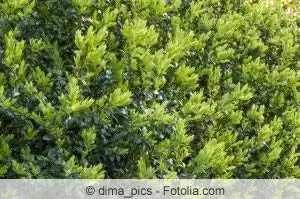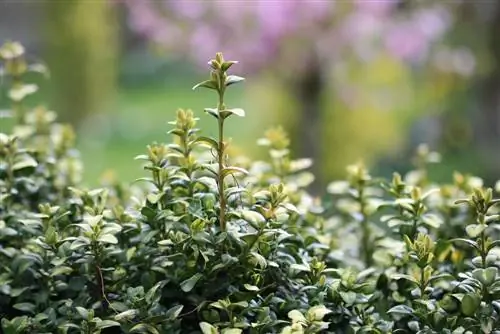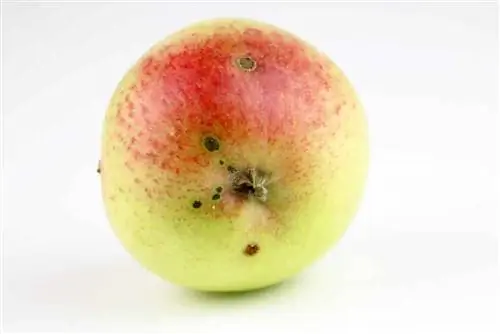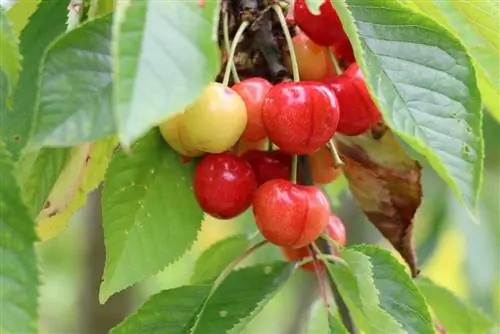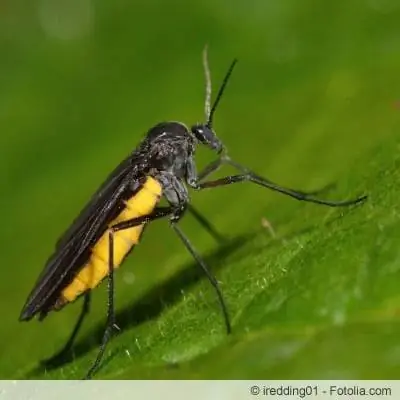- Author admin [email protected].
- Public 2023-12-17 03:39.
- Last modified 2025-06-01 06:48.
The boxwood is a very slow-growing plant that hobby gardeners need a lot of patience for. It is all the worse when such a plant is suddenly attacked by pests, for example boxwood fungus. However, there are ways to prevent this!
Anyone who owns a boxwood actually has a plant in their own garden that is relatively undemanding and requires little effort. However, there is a big risk for this plant that can even lead to death - and that is the boxwood fungus or Cylindrocladium buxicola fungus. However, with good care and a little observation of the plant, something worse can be prevented.
A serious disease of the boxwood
The boxwood fungus or Cylindrocladium buxicola fungus is a serious disease of the boxwood. The occurrence of this disease was first documented in 2004, but the occurrence of this disease has increased significantly since then and this fungus has therefore become one has become important to boxwood owners. The fungus attacks plants in tree nurseries as well as in public and private parks, cemeteries and gardens. The damage caused by the fungus is immense. It is therefore urgently necessary to protect the boxwood from the spread of the fungus through close and regular observation as well as optimal site conditions.
What does an infected boxwood look like?

The most obvious symptom that the boxwood is affected by the dreaded fungus are the usually dark brown, but sometimes also light brown spots that become darker towards the edge and that spread on the so-called leaf blades. As the disease progresses, the individual spots then merge. Sometimes the spots can also have an orange-brown color with a dark border. On shoots that are affected by the fungus, dark, black stripes can be seen in the early stages of the infection before the infection spreads to the leaves. As the disease progresses, the leaves fall off, then the shoots and finally the entire plant dies. It can be confused with boxwood cancer. With this disease, however, the black stripes on the shoot and simultaneous leaf fall do not occur.
The boxwood is affected by the fungus when
- the shoots have black stripes
- the leaves are spotted brown and the spots are spreading
- leaf fall is recorded
Illness progression
In order for an infection with the fungus to be possible, the leaves must be wet for a longer period of time - at least five hours. After the fungus has germinated, it continues to penetrate the still he althy tissue of the plant. If the fungus has the optimal growth conditions mentioned, then the first spots on the leaves can be seen just a week after the plant was infected and the leaves will not be long in coming. If there is high humidity, a female coating often appears on the undersides of the leaves of infected plants, which in turn helps the fungus to spread widely on the plant. The spores themselves are further dispersed by splashes of water. In order to survive, the fungus forms extremely long-lasting spores, also known as chlamydospores, which can survive on infected and fallen leaves in the soil for at least four years, thus promoting the further spread of the disease.
Scientific studies have shown that the fungal disease can also be latent. This means that the boxwood carries the pathogen, but no symptoms occur. When and under what conditions the disease ultimately breaks out in such a latently diseased boxwood or how this outbreak can be prevented has not yet been comprehensively researched.
The host plants of the Cylindrocladium buxicola fungus
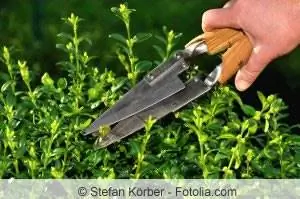
Infection by the fungus only occurs in plants that belong to the boxwood family. For hobby gardeners, only the Buxus and the Pachysandra, also known as the fat man, are significant. Experience has shown that pachysandra is less sensitive to infestation, while other boxwood species vary in their susceptibility. In general, it is a fact that all types of Buxus can become ill with the fungus. The so-called Sarcococca can also be infected by the fungus, although it is not of great horticultural importance in Germany.
Countermeasures for fungal infestation
Since wetness of the leaves is an important factor for the infestation and spread of the fungus, avoiding this leaf moisture is the best solution to reduce the likelihood of an infestation with the fungus. However, this is often difficult to implement outdoors. Therefore, location can be very important in protecting against infestation. A location that is more open to the wind and sunny helps the plant leaves dry out, which also reduces the risk of infection. If the plant is watered, this irrigation water should only reach the roots and not flow over the foliage of the boxwood.
In order to prevent infestation of the plants in your own garden, precautions can be taken when selecting the plants. The very common variety called Suffruticosa is considered to be particularly susceptible to the fungus. The boxwood variety Arborenscens, on the other hand, is less susceptible to fungal attack. In multi-year variety tests it was also found that the Herrenhausen and Faulkner varieties of boxwood are the least sensitive to fungal attack. However, the risk of fungal infestation cannot be easily avoided by choosing a variety.
It is important to pay attention to whether it is possibly infected when purchasing the plant. If there is suspicion or if a plant is obviously diseased, no other plants should be purchased from this stock. Important indicators of an infestation are blackened shoots and leaf fall.
Tip:
Take a close look before diagnosing, because pure shoot death does not have to be caused by the fungus. Scale insects, for example, can also trigger similar symptoms here.
Acute fungal infestation - what to do?
If a plant is acutely affected by the fungus, it should be removed and destroyed along with the fallen leaves. This can be done with residual waste or by burning it. It is important to remove the top layer of soil in the plant area affected by a fungus, as the pathogen can persist in the soil for several years.
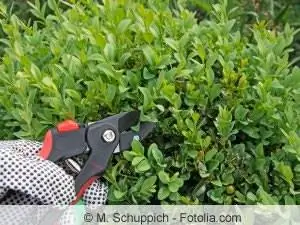
Used equipment, tools and shoes as well as gloves that have come into contact with the infected plant or the soil must be thoroughly cleaned after work and, if possible, disinfected before further planting is carried out. Even if other plants cannot be infected by the fungus, it can be carried into the soil and then cause an infection of a boxwood tree after years.
In acute fungal infestation
- immediately remove and destroy the affected plants
- remove the soil surface to remove embedded spores
- do not plant new boxwoods in this area
- clean used equipment, tools, gloves and shoes thoroughly
Direct replanting with a Buxus is not recommended.
Fungicide use
Tests have shown that the infestation with the Cylindrocladium buxicola fungus can hardly be controlled with fungicides. Experience has shown that the use of fungicides only makes sense as a preventive measure. If symptoms are already visible, spraying the plants will be unsuccessful. In this case, only so-called hygiene measures such as removing and destroying the infected plants are effective. However, protecting plants that have not yet been infected with fungicides is recommended in the vicinity of infected plants. Experience has shown that fungicides available to small and home gardeners are effective in preventing infestation. These include preparations with the active ingredients tebuconazole, difenoconazole and azoxystrobin.
Helpful active ingredients to prevent fungal infestation:
- Tebuconazole
- Difenoconazole
- Azoxystrobin
Frequently asked questions about boxwood fungus
Which conditions optimize fungal growth?
The fungus has optimal growth conditions in warm, humid summers. For the fungus to spread, the leaf surface must be continuously moist for at least five hours, as only then can the spores penetrate the leaves and infect the plant.
How do I recognize the disease in its early stages?
Dark brown to black discolored shoots, dark brown spots on the leaves and leaf fall clearly indicate the infestation. At the same time, whitish colored spore deposits can be seen on the undersides of the leaves.

